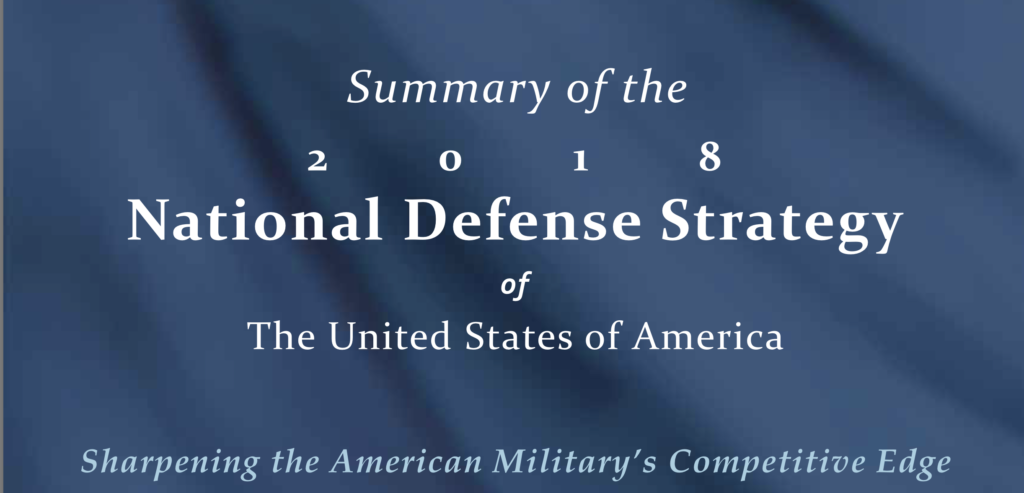By WILLIAM MACKENZIE
Those strategies will help fulfill the National Defense Strategy (NDS). America faces an uncertain world — the fate of the New START Treaty, revanchist geopolitical land-grabs, the race towards 5G, the drive for supremacy in Artificial Intelligence, and military modernization are frequently discussed in a vacuum. Though crucial, they often fail to be prioritized because they are not clearly linked to an overarching strategy. If the United States cannot better align its actions, messaging, and strategy and do it in a unified fashion — as it did during the Cold War — it risks reductions to military readiness and our ability to effectively compete with adversaries.
Recent events like the killing of Iranian Gen. Qasem Soleimani elicited responses from across the American political spectrum. Republicans heralded them as a show of American strength, one that sent deterrence signals to malign actors. Democrats — while not heartbroken over the killing — pushed back against the decision and questioned the Trump administration’s strategy.
Such radical departures from traditional foreign policy prompt the question: what are the strategic and operational goals of those in the White House and Pentagon, and who are these decision makers on any given day? The current revolving door of Trump appointees makes this a difficult question to answer.
Traditionally, a series of documents guide policymakers’ decisions in the defense and foreign policy realms. Chief among these are the National Defense Strategy (NDS), the National Military Strategy, the Defense Planning Guidance and the National Security Strategy. Notably, in the 2018 National Defense Strategy, the Pentagon shifted its focus away from combatting violent extremist organizations and toward that of great power competition. In the NDS, DoD articulated its strategy to compete, deter and win against great power rivals like Russia and China.
However, the spasmodic foreign policy of the Trump administration illustrates America’s difficulty in pursuing long-term strategic goals in an increasingly unpredictable and multi-polar world. Of course, every administration is forced to grapple with the news-of-the-day as it struggles to implement its long-term strategic goals. In no other period was this more apparent (and successful) than during the Cold War.
The 45-year standoff between the United States and the Soviet Union—notwithstanding the horrific loss of life and human suffering that Cold War proxy wars inflicted upon millions of innocents around the world—was a successful forcing mechanism for orienting military resources and political capital to help sustain America’s qualitative advantages over the long-term. During that period, existential threats directed DoD’s attention and shaped its decision-making processes and strategies. For instance, during the Cold War DoD devised two major Offset Strategies that galvanized incredible amounts of resources and manpower to tip the correlation of forces between the superpowers back toward the United States.
Today, unlike the Cold War, the lack of clearly prioritized threats facing the United States has resulted in unproductive foreign policy proposals and military modernization efforts that have only served to weaken American readiness.
While the 2018 NDS urges the United States to prepare for future competition and potential conflict with Russia and China, it does little to guide or weigh the prioritization of threats that should be taken most seriously. Of the litany of developing programs, concepts, and efforts undertaken by DoD, which of these should take priority: procuring additional naval surface combatants; increasing force posture in Europe; refining Expeditionary Advanced Basing Operations (EABO); developing the Space Force; or investing in hypersonic missiles defenses; expanding and increasing the defense capacity of airbases in the Indo-Pacific theatre? In fact, DoD leaders and policy makers don’t have an answer, as each initiative is shielded by its parent service and constituencies’ representatives. Only senior leaders in the Pentagon and White House can make the kinds of decisions needed to impose longer term guidance.
This is not to suppose the US should develop dual Offset Strategies for Russia and China. The US already benefits from its previous Offset Strategies and has accrued interest and benefits from those decades’ old investments.
“In the years ahead, we need to get back to 3 to 5 percent real growth annually,” Defense Secretary Mark Esper said Thursday. But in the near-term, “we have to brace ourselves that at best, defense spending will be level.”
As with all things, the perfect solution should not be the enemy of the good. Faced with what’s likely to be a century’s long competition with China, the US should invest in fundamentals like resilient C4ISR systems, airpower and long-range munitions. Such procurements are more fungible than inordinately narrow and expensive programs that invert the cost-benefit ratio (think ICBM—or hypothetical hypersonic missile defense systems).
Driven by what should be reclassified as a New Cold War, the US must begin to focus its efforts vis-à-vis China in a way that prioritizes the long-term threat over attempting to “offset” every single threatening adversarial capability or menacing range rings of anti-access area denial missile defense systems.
William Mackenzie, who served five years in the Marine Corps, is a defense expert at the Center for a New American Security.

No comments:
Post a Comment